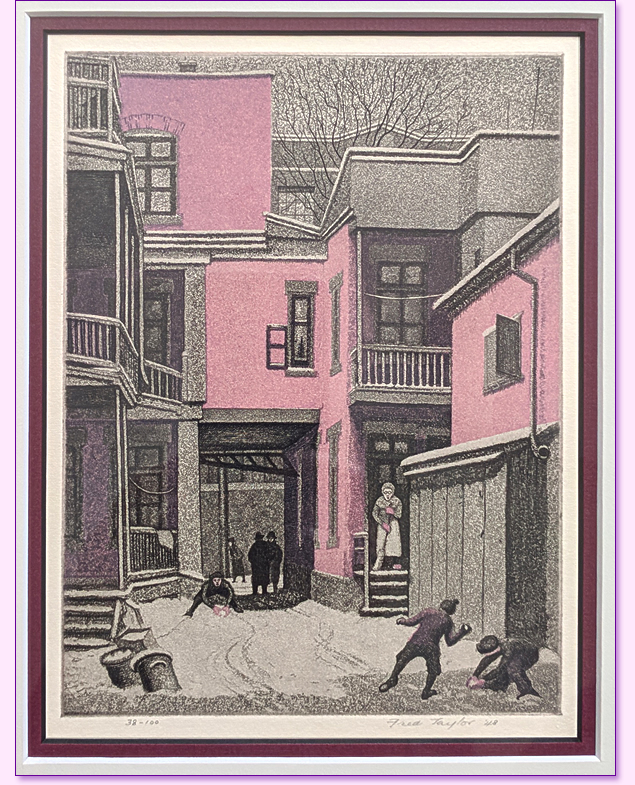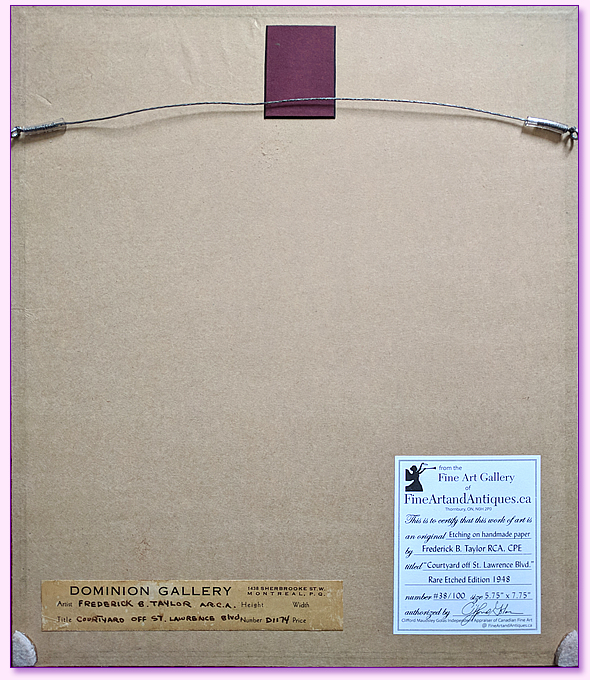
Listed Canadian Artist: 1906-1987
Rare Aquatint Etching: Signed, dated and numbered by the artist
Known title: “Courtyard off St. Lawrence Blvd.”
Signed: Fred Taylor '48, numbered 38/100
Image Size: w: 5.75 in. by h: 7.75 in.
Condition: pristine and original, with no condition issues whatsoever
Framed: Archivally encased using acid-free, rag content materials throughtout
Art Association Memberships: The Royal Canadian Academy, Society of Painters & Etchers and the Canadian Society of Graphic Arts
A Note of Interest: Frederick B. Taylor, RCA was a prolific, well respected 20th century Montreal artist and printmaker, whose hand-pulled works seldom come onto the open gallery marketplace. This specific aquatint etching by Fred is an exceedingly rare print that, in over thirty years while knowing of its existance, we have never seen a copy of one before acquiring this hand-pulled edition, and no other examples of this aquatint have ever been recorded in previous art auction records over that same period of time.
It's believed that Fred produced no more than six or so different aquatint etchings in his lifetime, as it is a time-consuming process in order to create and print this type of multiple plate etching.
Fred hand-pulled this aquatint etching in 1948, and as he did with a few of his other favourite settings, he later produced an edition of 100 serigraphs of this scene in 1957 on a slightly larger format for a co-operative art project. A sample of which is displayed below
It is a little known fact that most of the later 1950's serigraphs of the same setting (pictured at the bottom) were framed and displayed in the hotel rooms of the Queen's Hotel in Montreal for a Canadian art project during the 1950's. They were displayed along with the works by several other noted early-to-mid 20th century Canadian artists such as, A.Y. Jackson, Albert Cloutier and A.J. Casson. While staying at the Queen's hotel in the 1950's you could also acquire one of these serigraphs from the hotel's giftshop for a very moderate price back then. Today, these serigraph prints have all increased in value considerably, but are still considered a sound investment, as awareness of the importance of mid 20th century hand-pulled fine prints continues to expand.
Though Fred hand-pulled 100 copies of the particular aquatint etching displayed here, through the passage of time and the fact that people sometimes overlook the true value in original prints, there is doubt that all 100 copies could still be in existence today. Which gives the etching listed here all the more status of being, indeed, a very rare edition of one of Fred's most lovable, valued and important hand-pulled aquatint prints.
Frederick Bourchier Taylor RCA, CPE, CSGA









![]()


![]()
![]()
 Fred Bourchier Taylor was born in Ottawa in 1906. By the 1930's and 40's he became nationally known for his paintings and etchings of war industry workers, his inner-city Montreal street scenes, and for his urban architectural settings. Fred Taylor, was also the younger brother of Canadian millionaire business tycoon and philanthropist, E.P. Taylor.
According to art historian Barry Lord, his parents disapproved of his artistic ambitions and insisted that he obtain a degree before he beginning art studies in earnest. In 1925, he enrolled at McGill University, Montreal, to study architecture, and at the same time maintained a high level of sporting activity, excelling both in skiing and boxing. Fred later created numerous works of art revolving around the sport of skiing. In 1927, he received the Anglin Norcross Historical Drawing Prize in Architecture and also the heavyweight boxing championship for McGill. In 1929, before completing his studies, he oversaw the construction of the Willingdon School at Notre-Dame-de-Grace for the Protestant School Board of Montreal, and in the same year, began drawing classes with Edmond Dyonnet.
Fred Bourchier Taylor was born in Ottawa in 1906. By the 1930's and 40's he became nationally known for his paintings and etchings of war industry workers, his inner-city Montreal street scenes, and for his urban architectural settings. Fred Taylor, was also the younger brother of Canadian millionaire business tycoon and philanthropist, E.P. Taylor.
According to art historian Barry Lord, his parents disapproved of his artistic ambitions and insisted that he obtain a degree before he beginning art studies in earnest. In 1925, he enrolled at McGill University, Montreal, to study architecture, and at the same time maintained a high level of sporting activity, excelling both in skiing and boxing. Fred later created numerous works of art revolving around the sport of skiing. In 1927, he received the Anglin Norcross Historical Drawing Prize in Architecture and also the heavyweight boxing championship for McGill. In 1929, before completing his studies, he oversaw the construction of the Willingdon School at Notre-Dame-de-Grace for the Protestant School Board of Montreal, and in the same year, began drawing classes with Edmond Dyonnet.
Following his graduation from McGill in 1930, he was hired to oversee architectural projects for the Bank of Montreal and received the Governor General’s medal for Professional Practice and Building Law, as well as a grant to further his art studies in Europe. In 1931, he trained with Charles-Edouard Jeanneret, known as Le Corbusier, one of the pioneers of what is called "Modern Architecture" and he also studied art history at the Sorbonne. Returning to Canada, Fred moved to Ottawa where he studied drawing and etching with Ernest Fosbery, and in early 1932, made his first forays into etching and engraving. Deciding at this time to abandon architecture, he established a printmaking studio and produced images of the many aspects of skiing, and also views of the Parliament buildings and other noted architectural settings.
Returning to London in January 1934, Fred studied drawing, etching and lithography at the London Central School of Arts and Crafts with Bernard Meninsky and W.P. Robins, and drawing and etching at the Goldsmith College of Art with J. Baleman and Stanley Anderson. Later that year, he returned to Ottawa and secured a commission to etch portraits of Canada’s prime ministers.
In 1937, Fred Taylor settled in Montreal with his wife, Hilary Miriam Magee, and established himself as a portrait painter. Being politically active, and along with other Montreal artists, he became involved with the Committee to Aid Spanish Democracy prior to WWII. At this time he produced etchings of the Montreal harbour and other prominent city architectural sites such as the Church of Mary Queen of the World, and the Sun Life Building, plus numerous picturesque street scenes.
With the outbreak of war in 1939, Fred started a campaign to persuade the Canadian Government to support a war art project that would document the war industry workers at home. This, he argued, would increase patriotism amongst the workers and promote loyalty to the cause. In the same year, he approached writer Stephen Leacock to sit for a portrait; the famous writer finally acquiesced and the portrait was later acquired by McGill University where Leacock had once lectured.
In 1941, he attended the Kingston Conference where more than 150 Canadian artists discussed the role of the artist in society and called for a war art program and Government commissions. Following the conference, Taylor became a Charter Member of the Federation of Canadian Artists (FCA). In 1943, he was very active in this artists society and became the FCA Chairman of the Quebec Region, and from 1944 to 1945, the National Vice-President.
After the war, Fred continued to execute paintings and prints of social realist subjects as well images of Montreal street life, back alleys and courtyards, old neighbourhoods, and scenes of children playing. He also traveled around the province of Quebec to Quebec City and the Charlevoix region, executing city and countryscapes.
In 1951, Taylor produced his final etching, and had a solo exhibition at the Dominion Gallery, Montreal, where he exhibited 80 paintings depicting views of Montreal, Quebec, and Nova Scotia. From 1950 to 1953, he painted a series of artworks focusing on labourers, such as fishermen, loggers and shore workers.
Between 1954 and 1959, Taylor began a series of long sojourns to Mexico with his second wife, the painter Nova Hecht, and by 1960, settled permanently in San Miguel de Allende. Afflicted with arthritis, he began to explore silkscreen printing. In 1963, after traveling in Europe for a few months, Taylor had a solo exhibition of his paintings at The Artlenders gallery in Montreal where he showed Mexican street scenes, markets, and portraits. He also began to sculpt in bronze and stone at this time.
Between 1963 and 1973, he had regular exhibitions in Montreal and Toronto, at the Dominion Gallery and at the Walter Klinkhoff Gallery, among others. In 1971, he donated 75 etchings to the Montreal Museum of Fine Arts.
Many of Fred's works display Taylor's highly attuned comprehension of the printmaking medium. He possessed a mastered hand in the art of printmaking as well as displaying meticulous attention to detail and the sophistication of the finished work. Throughout his long career, Taylor exhibited widely in Canada, the United States, England and Mexico, and between 1932 and 1963, his work was the subject of 14 solo exhibitions. Fred Taylor passed away in San Miguel de Allende in 1987, leaving behind his third wife, Olga Taylor.
This is a partial extract from the Dictionary of Canadian Artists, volumes 1-8 by Colin S. MacDonald, and volume 9 (online only), by Anne Newlands and Judith Parker, National Gallery of Canada.
Lastly an Interesting Thought: This is a direct quote from Alan Klinkhoff, of the Alan Klinkhoff Galleries, Fred's art dealer in Montreal, concerning the works of Frederick Bourchier Taylor...
"Deserving of greater recognition in a broader study of Canadian urban artists, Fred Taylor is most certainly among the finest and an artist of particular socio-political interest".
Print Ref No: 6IRB19CON-S/AIOEX
Frederick Bourchier Taylor RCA,Canadian Artist
Updated January 16, 2025 |
|
|---|



